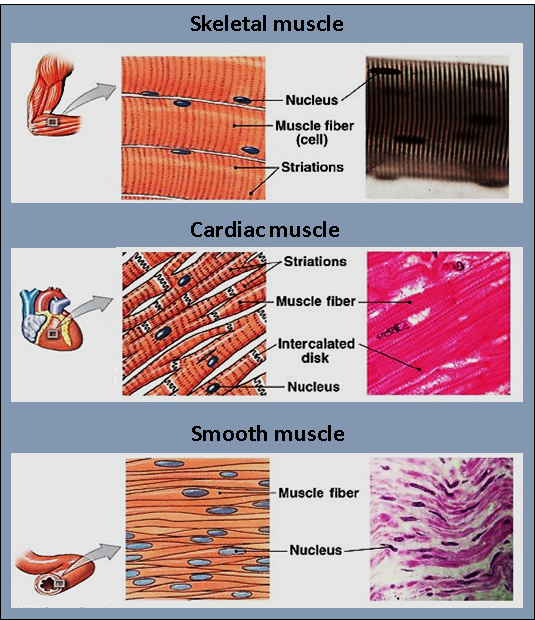How Do Voluntary and Involuntary Muscles Work in the Human Body?
The muscular system is responsible for body movements, posture, and the circulation of substances like blood and food within the body. Humans have more than 700 muscles, accounting for nearly 40% of total body weight. These muscles are attached to bones, blood vessels, and various internal organs. They work by contracting and relaxing, enabling our bodies to move and perform essential functions.
Muscles in our body can be grouped into three main types:
Skeletal Muscles: Usually attached to bones and responsible for voluntary movements.
Smooth Muscles: Found inside organs such as blood vessels and intestines, controlling involuntary actions.
Cardiac Muscles: Located only in the heart, ensuring continuous pumping of blood.
Before understanding the difference between voluntary and involuntary muscles, let us see how they are broadly classified and how they function.
Key Differences Between Voluntary and Involuntary Muscles
When you explore the difference between voluntary and involuntary muscles with examples, you will notice that voluntary muscles primarily enable movements you control consciously, while involuntary muscles maintain critical functions inside the body without your active decision.

Classification of Muscles in the Human Body
Skeletal Muscles
They were found attached to the skeleton by tendons.
Under voluntary control (you can decide when to move your arm or leg).
Appear striated (striped) under a microscope.
Contains multiple nuclei in each cell.
Smooth Muscles
Present in the walls of internal organs like the intestines, stomach, and blood vessels.
Involuntary in nature (work automatically without conscious control).
Spindle-shaped cells with a single nucleus.
Not striated under a microscope.
Cardiac Muscles
Found only in the heart.
Involuntary in action, as the heart beats continuously without conscious effort.
Appear striated and branched.
Usually, they have one nucleus per cell but may occasionally have more.
Voluntary Muscles
Voluntary muscles are controlled by the somatic nervous system. You can move them consciously—like raising your arm or walking. These muscles:
It has a cylindrical shape and can be quite long.
Possess multiple nuclei per fibre.
Display striations (light and dark bands).
Requires a high amount of energy, which is why they can get tired after prolonged activity.
Voluntary and involuntary muscles examples for the voluntary category include:
Muscles of the arms and legs (e.g. biceps, triceps).
Muscles in the abdominal wall.
The tongue.
The diaphragm (though it can also function involuntarily for breathing).
Involuntary Muscles
Involuntary muscles work under the autonomic nervous system. They handle essential internal processes like digestion and blood flow. You cannot consciously control them. Involuntary muscles are of two main types:
Smooth Muscles
Found in the walls of organs, including the stomach, intestines, uterus, and blood vessels.
These muscles help move substances like food and blood through the body.
They have spindle-shaped cells with a single nucleus each.
Cardiac Muscles
Found only in the heart.
Have striations and branched fibres.
Work continuously to pump blood around the body without fatigue.
Some voluntary and involuntary muscles examples for the involuntary category are:
Smooth Muscles: In the walls of the alimentary canal, blood vessels, respiratory tract, and ducts of glands.
Cardiac Muscles: In the heart, ensuring continuous heartbeat.
Additional Points about Voluntary and Involuntary Motor Muscles
Voluntary muscles (skeletal muscles) can be consciously controlled, so they are also referred to as voluntary motor muscles.
Involuntary muscles (smooth and cardiac) act independently of conscious thought, which is why they are sometimes called involuntary motor muscles.
A unique example is the diaphragm. While it primarily functions involuntarily for breathing, you can also control it voluntarily to an extent (holding your breath, for instance).
Quick Quiz (with Answers)
Test your understanding with this short quiz:
Which type of muscle is found in the walls of the stomach?
A. Skeletal
B. Smooth
C. Cardiac
D. None of the above
Answer: B. Smooth
Which muscle type never gets fatigued?
A. Skeletal
B. Cardiac
C. Smooth
D. Voluntary muscles only
Answer: B. Cardiac
Which nervous system primarily controls voluntary muscles?
A. Somatic nervous system
B. Autonomic nervous system
C. Peripheral nervous system
D. Central nervous system
Answer: A. Somatic nervous system
What is the primary function of cardiac muscles?
A. Move limbs
B. Aid in digestion
C. Pump blood
D. Support posture
Answer: C. Pump blood
Related Topics


FAQs on Voluntary vs Involuntary Muscles: Clear Differences for Students
1. Are there muscles in the human body that can be both voluntary and involuntary?
Yes. The diaphragm is one such example. You can consciously control it (when you hold your breath), but it also works involuntarily for normal breathing.
2. Why do voluntary muscles get fatigued more quickly than involuntary muscles?
Voluntary muscles (like those in the arms and legs) require much energy to sustain rapid and forceful contractions. Over time, this high energy demand leads to the accumulation of metabolic by-products that cause fatigue.
3. How do cardiac muscles keep contracting without rest?
Cardiac muscles have numerous mitochondria and a rich blood supply that ensures constant oxygen and nutrients. This helps them work continuously without tiring.
4. What is the difference between voluntary and involuntary muscles with examples?
Voluntary muscles (e.g. biceps, tongue) are under conscious control, have multiple nuclei, and can become fatigued. Involuntary muscles (e.g. intestinal walls, heart) operate automatically, often have single nuclei, and do not usually fatigue.
5. What is the difference between voluntary and involuntary motor muscles?
Voluntary motor muscles are directed by the somatic nervous system (e.g. skeletal muscles), whereas involuntary motor muscles are controlled by the autonomic nervous system (e.g. smooth and cardiac muscles).










